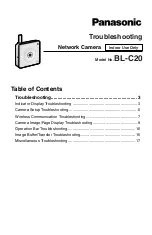
www.RuggedCom.com
3
RuggedServer™ RS400
RuggedServer™ RS400
4-Port Serial Device Server with Integrated 4-Port Managed Ethernet Switch
Serial IP Encapsulation
Many 'legacy' devices (RTU, PLC, IED, etc.) only
support serial communications via RS232 or RS485.
ROS
®
encapsulates the serial data within a TCP
connection allowing these devices to be reached via
an IP network. A wide range of baud rates, frame
packetization options, and diagnostics allows any serial
protocol to function. The RS400 has specific support for
the following serial protocols:
.
Raw Socket serial encapsulation
.
Modbus TCP (client and server)
.
DNP 3
.
WIN and TIN
.
Microlok
MODBUS TCP
The Modbus protocol is ubiquitous in the industrial
control and automation world. ROS
®
converts Modbus
RTU master/slave serial data packets to Modbus TCP
client/server packets for transmission over an IP network.
This allows communications to Modbus RTU slaves via
Ethernet and allows multiple masters to poll the same
slave device.
Remote Dial-Up Access
A V.90 modem coupled with the PPP (Point to Point
Protocol) allows ROS
®
to provide dial-up access via
POTS (plain old telephone system) providing connectivity
to serial devices and Ethernet LAN. PAP/CHAP
authentication provide security against
unauthorized access.
Enhanced Rapid Spanning Tree Protocol (eRSTP™)
RuggedCom eRSTP™ allows the creation of
fault-tolerant ring and mesh Ethernet networks that
incorporate redundant links that are 'pruned' to prevent
loops. eRSTP™ yields worst-case fault recovery1 of
5ms times the 'bridge diameter' and allows rings of up
to 160 switches. For example, a ring of ten switches
will have fault recovery times under 50ms. eRSTP™
implements both STP and RSTP to ensure
interoperability with commercial switches unlike
other proprietary 'ring' solutions.
Quality of Service (IEEE 802.1p)
Some networking applications such as real-time control
or VoIP (voice over IP) require predictable arrival times for
Ethernet frames. Switches can introduce latency in times
of heavy network traffic due to the internal queues that
buffer frames and than transmit on a first come first serve
basis. ROS
®
supports 'Class of Service' in accordance
with IEEE 802.1p that allows time critical
traffic to jump ahead to the front of the queue
thus minimizing latency and reducing jitter to allow such
demanding applications to operate correctly. ROS
®
allows
priority classification by port, tags, MAC address, and IP
type of service (ToS). A configurable "weighted fair
queuing" algorithm controls how frames are emptied
from the queues.
VLAN (IEEE 802.1Q)
Virtual local area networks (VLAN) allow the segregation
of a physical network into separate logical networks with
independent broadcast domains. A measure of security is
provided since hosts can only access other hosts on the
same VLAN and traffic storms are isolated. ROS
®
supports 802.1Q tagged Ethernet frames and VLAN
trunks. Port based classification allows legacy devices to
be assigned to the correct VLAN.
IGMP Snooping
ROS
®
uses IGMP snooping (Internet Group Management
Protocol v1&v2) to intelligently forward or filter multicast
traffic streams (e.g. MPEG video) to or from hosts on the
network. This reduces the load on network trunks and
prevents packets from being received on hosts that are
not involved. ROS
®
has a very powerful implementation of
IGMP snooping that:
.
Can be enabled on a per VLAN basis
.
Detects and filters all multicast streams regardless of
whether subscribers exist
.
Supports "router-less" operation by supporting an
"active" mode
.
Restores traffic streams immediately after an RSTP
topology change
Ethernet Port Mirroring
ROS
®
can be configured to duplicate all traffic on one
port to a designated mirror port. When combined with
a network analyzer, this can be a powerful
troubleshooting tool.
Ethernet Port Configuration and Status
ROS
®
allows individual ports to be 'hard' configured for
speed, duplex, auto-negotiation, flow control and more.
This allows proper connection with devices that do
not negotiate or have unusual settings. Detailed status
of ports with alarm and SNMP trap on link problems
aid greatly in system troubleshooting.
1 eRSTP fault recovery times may be approximated as follows:
For 100 Mbps, fault recovery performance is <5ms/hop
For 1,000 Mbps, fault recovery performance is <5ms/hop + 20ms
Ethernet Switch Management Features


























